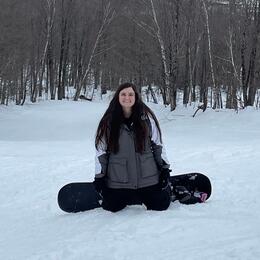The ECHO Leahy Center for Lake Champlain was buzzing with concerned Vermonters on August 31st as they learned more about pollinator friendly gardening and the threat that toxic pesticides, especially a particularly dangerous class called neonicotinoids (neonics) have on the future of our food systems, ecosystems, and biodiversity. This Protect our Pollinators event organized by Vermont Public Interest Research Group (VPIRG) and co-hosted by Audubon Vermont and other allied organizations drew in an impressive crowd. Over 180 people signed up to attend. This was my first event I had gone to as a policy intern at Audubon Vermont. It was only my first week! What a cool and inspiring way to start this experience with Audubon Vermont, though.
I already knew that birds are so important for our ecosystem for so many reasons, including pest control but, as the presenters emphasized, Ruby-throated Hummingbirds are also critical for their pollination services. Unfortunately, birds are currently threatened by the ubiquitous and untargeted exposure of neonics both directly by poisoning through ingestion and indirectly through the devastation of their insect food supply. Certain characteristics make neonics particularly harmful. When agricultural crop seeds are treated with a neonic coating (which is the most common method of application), the chemicals become systemic in the plants, meaning the toxic components grow into every tissue including leaves, stems, and the pollen and nectar of flowers. Worse still, less than 5% is actually absorbed into the target crop plants, with the rest highly mobile in surface and groundwater or persists in soils for months to years after application. The symptoms of toxicity in birds can cause neurological and reproductive issues, malnutrition, and death. All resulting from as little as a single seed. Even at low doses, these chemicals are highly lethal to a plethora of beneficial invertebrates like earthworms and terrestrial and aquatic insects. These are critical food sources for birds, especially aerial insectivores like swallows, bluebirds, swifts, and flycatchers.
The event began with organizations hosting educational tables, talking to interested attendees one-on-one, passing out educational fliers and brochures, and encouraging people to sign the VPIRG petition to stop the legal use of neonic-treated seeds in Vermont.
At around 6 o’clock, we all found our seats to listen to talks from Paul Burns: Executive Director of VPIRG, Samantha Alger of the UVM Bee Lab, and Charlie Nardozzi from All Things Gardening on Vermont Public. But first, we participated in a sing along led by the Honeybee Steelband. This song was not only well performed but successfully got the crowd focused and energetic for the following presentations. Paul Burns gave the introductions, introducing the mission, VPIRG’s work, the petition’s goal, and the presenters.
Our first presenter, Samantha Alger, made a few things very clear. Our bee populations are declining rapidly, neonics are extremely harmful and contributing to this decline, and if there isn’t a change soon then our food supplies and general environmental health will be devastated. She explained to us that bees and other pollinators such as moths, butterflies, beetles, and flies play a role in one out of every three bites of food we eat. This cannot be taken lightly.
Further, the threat posed to our native bees spans past the neonics. There are over 300 native species of bees in Vermont. Honeybees are not native to the United States. They are susceptible to contracting disease carrying Varroa mites. While our native bee populations are not susceptible to contracting these mites, they are susceptible to the diseases spread by the honeybees who are infected. She advises that the best course of action to combat this issue is to increase the numbers of flowers available. Think of the flowers as dirty doorknobs, covered in germs waiting to be spread. By increasing the numbers of flowers and therefore available pollen and nectar sources, there is a dilution effect and the likelihood of landing on a germ-infested flower decreases.
Our second presenter, Charlie Nardozzi, gave advice and encouragement as to what individuals can do to make a difference in their own backyard. He started by suggesting which species of flowers, shrubs, and trees are most beneficial to pollinators and wildlife. Just 5% of native plant species support 75% of pollinators! Oaks, cherries, willows, birches, poplars, and crabapples are some of the best. He warned against the use of pesticides and cautioned against the use of hybrid plants. They are often sterile (and therefore do not provide viable pollen) or have been selectively bred to the point they are no longer recognizable to their specialist host insects. Charlie also suggested ideal times and strategies to mow your lawn (or not). He provided a surprising tip about No Mow May. He said that while this well intentioned slogan has picked up in popularity, it is actually not the answer. Instead, have a portion of your yard that you mow and a portion that you don’t. Otherwise, the good you created by not mowing in May is immediately gone by going back to mowing like normal in June, July, and August. By leaving a portion un-mowed, everyone wins.
It is clear from the significant turn out, the enthusiasm to learn from all in attendance, and the audience’s passionate reactions that this issue matters to Vermonters. Vermont cares about its inhabitants and its landscape. Neonics are a significant threat to both. It is time to take legal action to ensure that the threat is stopped now, before it becomes too late.
Check out the Protect our Pollinators website to learn more.









